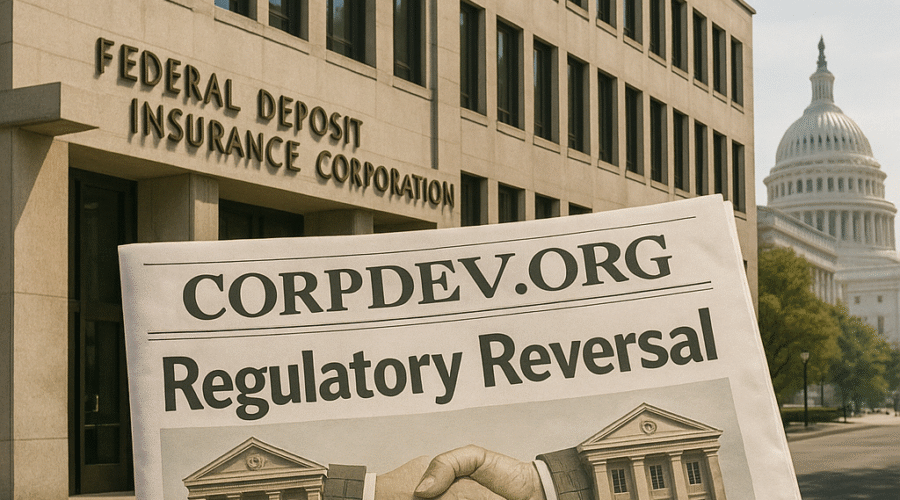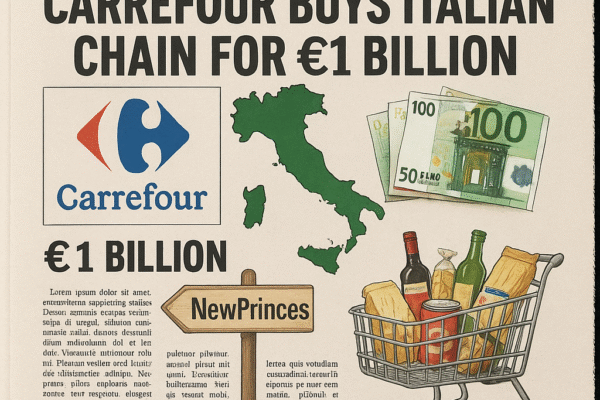In a sweeping deregulatory move, federal banking authorities and Congressional Republicans have dismantled two pillars of the Biden administration’s financial policy framework. The Federal Deposit Insurance Corporation (FDIC) unanimously voted to rescind its 2024 bank merger review standards on May 20, 2025, reinstating pre-2024 guidelines while initiating a broader policy overhaul[1][2][4]. Concurrently, the House of Representatives passed legislation nullifying the Office of the Comptroller of the Currency’s (OCC) September 2024 merger rule through the Congressional Review Act (CRA), completing a 220-207 party-line vote that sends the measure to President Trump’s desk[3][6][12]. These coordinated actions signal a fundamental shift in merger review philosophy, replacing heightened antitrust scrutiny with streamlined approval processes that banking trade groups argue will enhance competitiveness while critics warn could accelerate industry consolidation.
Anatomy of the Regulatory Rollbacks
FDIC’s Return to Pre-2024 Merger Framework
The FDIC board’s 3-0 decision terminates a policy that had expanded merger evaluation criteria to include non-deposit concentration metrics like small business lending volumes and introduced mandatory financial stability analyses for deals creating institutions over $100 billion in assets[2][4][15]. By reinstating its 2008 merger policy statement on an interim basis, the agency reverts to deposit-based market concentration assessments and eliminates requirements for public hearings on mergers exceeding $50 billion in assets[4][5][8]. FDIC Acting Chairman Travis Hill emphasized this “return to historical norms” aims to reduce application processing uncertainties that had chilled merger activity since the 2024 rules took effect[5][11].
Congressional Nullification of OCC Merger Reforms
The House’s CRA resolution dismantles the OCC’s elimination of automatic approvals for uncontested mergers after 15 days – a procedural cornerstone of bank M&A since 1996[3][13]. By prohibiting future “substantially similar” regulations, the measure institutionalizes Trump administration priorities favoring expedited deal reviews[6][12]. House Financial Services Subcommittee Chairman Andy Barr (R-KY) framed the legislation as necessary to prevent “politicization” of merger approvals, arguing streamlined processes help regional banks compete against megabanks[6][13].
Industry Impact and Strategic Implications
Revitalizing Regional Bank M&A
Banking analysts anticipate these changes will catalyze consolidation among mid-sized institutions seeking scale to compete in digital banking markets. The FDIC’s reversion to deposit-focused antitrust analysis removes regulatory hurdles for mergers combining complementary lending specialties – a critical consideration for regional banks expanding into adjacent markets[2][10]. K&L Gates partner Grant Butler notes the changes could halve merger review timelines for sub-$100 billion deals, particularly benefiting community banks pursuing strategic partnerships[10].
Redefining Systemic Risk Parameters
By scrapping mandatory financial stability reviews for mergers creating $100+ billion institutions, regulators remove a key constraint on domestic “super-regional” bank formation[15]. This policy shift enabled recent approvals like Capital One’s $35 billion Discover acquisition – a deal that would have faced heightened scrutiny under the 2024 framework[3]. Critics including Rep. Maxine Waters (D-CA) warn this could recreate “too-big-to-fail” institutions, while proponents argue scale enhances resilience against fintech disruptors[3][12].
Legal and Operational Challenges
Navigating Transitional Uncertainty
Despite the FDIC’s reinstatement of pre-2024 guidelines, lingering uncertainties persist during the interim period before comprehensive policy revisions. The agency’s Financial Institution Letter FIL-13-2025 confirms existing merger applications will be evaluated under the reinstated 2008 framework, but advises institutions to anticipate future rulemaking on digital asset considerations and fintech partnerships[9][11]. Banking legal teams must now reconcile FDIC’s deposit-centric approach with the Federal Reserve’s continued use of broader product market definitions in merger reviews[14].
Compliance Infrastructure Adjustments
Financial institutions that had upgraded systems to meet the 2024 rules’ expanded data reporting requirements face potential stranded costs. The rescinded policy required granular reporting on 17 non-deposit business lines – from agricultural loans to payment processing volumes – necessitating significant IT investments[2][14]. While some banks may maintain these capabilities for internal analytics, others are likely to scale back data collection efforts absent regulatory mandates[10].
Political Economy of Deregulation
Partisan Divides in Financial Policy
The regulatory reversals exemplify deepening ideological rifts in financial regulation. Democratic lawmakers uniformly opposed both actions, with Sen. Elizabeth Warren (D-MA) condemning them as “a green light for Wall Street greed”[12]. Conversely, Republican leaders framed the moves as necessary corrections to bureaucratic overreach, with Senate Banking Committee ranking member Tim Scott (R-SC) praising the restoration of “free market principles in banking”[6][13]. This polarization suggests future policy volatility as control of Congress and the White House fluctuates.
Interest Group Dynamics
The American Bankers Association (ABA) played a pivotal role in shaping the deregulatory agenda, having lobbied aggressively against the 2024 rules’ “vagueness and open-ended discretion”[2][4]. ABA CEO Rob Nichols hailed the FDIC’s decision as vital for maintaining a “diverse banking ecosystem”[2]. However, consumer advocates like the Center for Responsible Lending warn reduced merger scrutiny could diminish credit access in minority communities – a concern partially validated by post-2008 crisis research showing consolidation correlates with branch closures in low-income areas[3][12].
Strategic Considerations for Market Participants
Dealmaking Opportunities
Investment bankers report surging client interest in potential mergers following the regulatory changes. Piper Sandler analysts identify three strategic vectors likely to drive near-term activity: 1) Regional banks acquiring fintechs to accelerate digital transformation, 2) Cross-market mergers creating $50-100 billion institutions, and 3) Specialty lenders combining to achieve national scale[10][15]. The eased regulatory environment makes stock-for-stock deals particularly attractive, avoiding cash outlays in a high-interest rate climate.
Risk Management Imperatives
While deregulation lowers procedural barriers, acquirers must still navigate post-merge integration risks amplified by economic uncertainty. Federal Reserve stress test scenarios for 2025 incorporate 6.5% unemployment and 30% commercial real estate value declines – conditions that could strain combined institutions’ capital buffers[7]. Successful integrators will need robust scenario planning frameworks to satisfy ongoing supervisory expectations despite reduced pre-approval requirements[9][11].
Conclusion: Reshaping the Financial Ecosystem
These regulatory shifts mark a watershed in U.S. banking policy, reversing a decade-long trend toward heightened merger scrutiny. While industry leaders celebrate reduced bureaucratic friction, the long-term consequences remain contested. Economists debate whether streamlined approvals will foster innovation through efficient capital reallocation or entrench oligopolistic structures. What’s clear is that dealmakers now operate in an environment valuing transactional velocity over prophylactic safeguards – a paradigm requiring updated playbooks for risk assessment, regulatory engagement, and post-merger value realization. As the FDIC embarks on its comprehensive policy review, market participants should anticipate continued evolution in merger review criteria, particularly regarding cryptocurrency integrations and climate risk disclosures.
Sources
https://www.law360.com/articles/2342923/fdic-nixes-biden-era-merger-rules-as-house-passes-occ-bill, https://bankingjournal.aba.com/2025/05/fdic-rescinds-2024-bank-merger-policy/, https://www.politico.com/live-updates/2025/05/20/congress/republicans-biden-era-bank-mergers-rule-congress-00361099, https://www.americanbanker.com/news/fdic-rescinds-biden-era-merger-policy-slew-of-pending-rules, https://www.fdic.gov/news/press-releases/2025/fdic-board-directors-approves-proposal-rescind-2024-bank-merger-policy, https://barr.house.gov/press-releases?id=64F0BA67-81B4-44E9-B40C-1F86B6BB62A7, https://www.cbsnews.com/news/tax-bill-house-gop-vote-this-week/, https://www.fdic.gov/news/financial-institution-letters/2025/fdic-statement-policy-bank-merger-transactions, https://www.fdic.gov/news/financial-institution-letters/2025/statement-policy-bank-merger-transactions-rescission-and, https://www.bankingdive.com/news/fdic-withdraws-merger-policy-brokered-deposits-proposal-hot-money/741531/, https://www.globalfinregblog.com/2025/03/fdic-conducts-regulatory-review-and-purge/, https://www.americanbanker.com/news/house-votes-to-rollback-occ-bank-merger-rule, https://www.bankingdive.com/news/occ-merger-expedited-review-senate-vote-overturn-trump-barr-kennedy-warren-capital-one-discover/747544/, https://www.fdic.gov/news/financial-institution-letters/2024/fdics-final-statement-policy-bank-merger-transactions, https://www.grip.globalrelay.com/107889/





